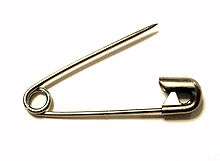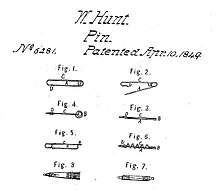Safety pin
The safety pin is a variation of the regular pin which includes a simple spring mechanism and a clasp. The clasp serves two purposes: to form a closed loop thereby properly fastening the pin to whatever it is applied to, and to cover the end of the pin to protect the user from the sharp point.

Safety pins are commonly used to fasten pieces of fabric or clothing together. Safety pins, or more usually a special version with an extra safe cover, called a nappy pin, or loincloth pin, are widely used to fasten cloth diapers (nappies), or modern loincloths, as the safety clasp, while remaining ingestion hazard,[1] prevents the baby girl or boy from being jabbed or pricked. Similarly, they can be used to patch torn or damaged clothing. Safety pins can also be used as an accessory in jewelry, like earrings, chains, and wristbands. Sometimes they are used to attach an embroidered patch. Size 3 is often used in quilting and may be labelled for purchase as a "quilting pin". Size 4 and larger may be called "blanket pins" and deemed acceptable as kilt pins for informal dress, depending upon design and appearance.
Early precursor
The fibula, a form of brooch, was invented by the Mycenaeans on the Greek Peloponnesus between the 14th and 13th Century BC, and is considered an early precursor to a safety pin since they were used in a similar manner. Fibulae were used by Greek women and men to help secure tunics.[2]
Invention of the safety pin


American mechanic Walter Hunt is regarded as the inventor of the safety pin that bears resemblance to those used today. The safety pin included a clasp that covered the point and kept it from opening, and a circular twist at the bend to act as a spring and hold it in place.[3] Charles Rowley (Birmingham, England) independently patented a similar safety pin in October 1849,[4] although the company no longer makes these.
Hunt made the invention in order to pay off a $15 debt to a friend. He used a piece of brass wire that was about 8 inches long and made a coil in the center of the wire so it would open up when released. The clasp at one end was devised in order to shield the sharp edge from the user.[5]
After being issued U.S. patent #6,281 on April 10, 1849,[6] Hunt sold the patent to W. R. Grace and Company for $400 (roughly $12,000 in 2019 dollars). Using that money, Hunt then paid the $15 owed to a friend and kept the remaining amount of $385 for himself. What Hunt failed to realize is that in the years to follow, W.R. Grace and Company would make millions of dollars in profits from his invention.[7][8]
Locking safety pin
The sharpened pin, that is attached to a coiled wire is connected with a cap that is hooked at the end of the wire. Pushing the pin into the opening of the cap secures the safety of the pin, and the clasp is the closed.[9]
Medical aspects
The laryngologist Dr. Chevalier Jackson devised special instruments for removing swallowed safety pins. Because small children often swallowed them and open pins could be lodged dangerously in their throats, Jackson called them "danger pins" and sometimes displayed arrangements of those he had extracted. Safety pin ingestion is still a common problem in some countries, including Turkey, today.[10]
Culture
During the emergence of punk rock in the late 1970s, safety pins became associated with the genre, its followers and fashion.[11] Some claim the look was taken originally from Richard Hell whom the British punks saw in pictures, and whose style they adopted.[12] This is disputed by a number of artists from the first wave of British punks, most notably Johnny Rotten, who insists that safety pins were originally incorporated for more practical reasons, for example, to remedy "the arse of your pants falling out".[13] British punk fans, after seeing the clothing worn by such punk forerunners, then incorporated safety pins into their own wardrobe as clothing decoration or as piercings, shifting the purpose of the pins from practicality to fashion. The safety pin subsequently has become an image associated with punk rock by media and popular culture outlets.[14]
Safety pins worn visibly on clothing became a symbol of solidarity with victims of racist and xenophobic speech and violence after the Brexit referendum in the United Kingdom in 2016. Later that year the symbol spread to the United States after Donald Trump's election to the presidency. Some commentators and activists derided the wearing of safety pins as "slacktivism," while others argued it was useful when connected with other, more concrete political actions.[15]
Tradition
Safety pins hold a value in certain cultures and traditions. In India pins are kept over generations and passed down to daughters. Ukrainians use pins as a way to ward off evil spirits when attached to children's clothing. In other countries a safety pin is a form of good luck.[16]
See also
- Drawing pin
- Infant clothing
- Fibulae and ancient brooches
- Paper clip
- Tie pin
Notes
- Türkyilmaz Z, Karabulut R, Sönmez K, Basaklar AC, Kale N (2007). "A new method for the removal of safety pins ingested by children" (PDF). Annals of the Academy of Medicine, Singapore. 36 (3): 206–7. PMID 17450267.
- "Brooches and Pins | LoveToKnow". LoveToKnow. Retrieved 2018-05-06.
- "Walter Hunt". National Inventors Hall of Fame. Archived from the original on 2007-07-14.
- "Charles Rowley". Charles Rowley. Archived from the original on 2009-10-26.
- Caballar, Rina. "Three Millennia of Safety Pins". The Atlantic. Retrieved 2018-05-05.
- "Walter Hunt". United States Patent and Trademark Office.
- "LILEKS (James) :: The Bleat 2017 TUESDAY". lileks.com. Retrieved 2018-05-05.
- Akcigit, Ufuk; Celik, Murat Alp; Greenwood, Jeremy (2016). "Buy, Keep, or Sell: Economic Growth and the Market for Ideas". Econometrica. 84 (3): 943–984. doi:10.3982/ECTA12144.
- "Safety Pin facts, information, pictures | Encyclopedia.com articles about Safety Pin". www.encyclopedia.com. Retrieved 2018-05-05.
- Türkyilmaz Z, Karabulut R, Sönmez K, Basaklar AC, Kale N (2007). "A new method for the removal of safety pins ingested by children" (PDF). Annals of the Academy of Medicine, Singapore. 36 (3): 206–7. PMID 17450267.
- Punks: A Guide to an American Subculture, p53, Sharon M. Hannon, ABC-CLIO, 2010
- Finney, Ross, A Blank Generation: Richard Hell and American Punk Rock. University of Notre Dame, Department of American Studies. p. 40
- Inside the Met's New Exhibit, 'Punk: Chaos to Couture'. Rolling Stone, May 7, 2013.
- Young, Sarah, The safety pin returns as punk becomes more relevant than ever. The Independent, October 17, 2016.
- Abad-Santos, Alex, The backlash over safety pins and allies, explained, Vox, Nov. 17, 2016.
- Caballar, Rina. "Three Millennia of Safety Pins". The Atlantic. Retrieved 2018-05-05.
External links
| Wikimedia Commons has media related to Safety pins. |
| Wikimedia Commons has media related to Fibulae. |